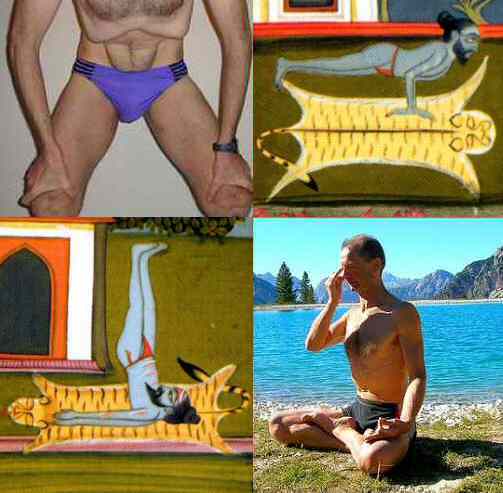|
Vivekamārtaṇḍa
The ''Vivekamārtaṇḍa'' is an early Hatha yoga text, the first to combine tantric and ascetic yoga. Attributed to Goraknath (also called Gorakshanath), it was probably written in the 13th century. It emphasises mudras as the most important practice. The name means "Sun of Discernment". It teaches khecarīmudrā (which it calls nabhomudrā), mahāmudrā, viparītakaraṇī and the three bandhas. It teaches six chakras and the raising of Kundalinī by means of "fire yoga" (''vahniyogena''). Sixfold system Unlike Ashtanga, the eightfold yoga of Patanjali, the ''Vivekamārtaṇḍa'' describes a system of six limbs: asana (posture), breath-restraint (which it calls ''pranasamrodha''), pratyahara (withdrawal), dharana (concentration), meditation, and samadhi; omitting the first two limbs of Ashtanga, namely the Yamas and Niyamas. The text claims that there are 84 yoga postures, but describes only two. Breath control, as in tantric texts but not otherwise in hatha yoga text ... [...More Info...] [...Related Items...] OR: [Wikipedia] [Google] [Baidu] |
Hatha Yoga
Hatha yoga (; Sanskrit ý§πý§Ýý§Øý•ãý§ó, International Alphabet of Sanskrit Transliteration, IAST: ''ha·π≠hayoga'') is a branch of yoga that uses physical techniques to try to preserve and channel vital force or energy. The Sanskrit word ý§πý§Ý ''ha·π≠ha'' literally means "force", alluding to a system of physical techniques. Some hatha yoga style techniques can be traced back at least to the 1st-century CE, in texts such as the Hindu Itihasa, Sanskrit epics and Buddhism's Pali canon. The oldest dated text so far found to describe hatha yoga, the 11th-century ''Amritasiddhi, Am·πõtasiddhi'', comes from a Tantra, tantric Buddhist milieu. The oldest texts to use the terminology of ''hatha'' are also Vajrayana Buddhist. Hindu hatha yoga texts appear from the 11th century onward. Some of the early hatha yoga texts (11th-13th c.) describe methods to raise and conserve bindu (vital force, that is, semen, and in women ''rajas ‚Äì'' menstrual fluid). This was seen as the physical esse ... [...More Info...] [...Related Items...] OR: [Wikipedia] [Google] [Baidu] |
Viparīta Karaṇī
Viparita Karani (; ) or legs up the wall pose is both an asana and a mudra in hatha yoga. In modern yoga as exercise, it is commonly a fully supported pose using a wall and sometimes a pile of blankets, where it is considered a restful practice. As a mudra it was practised using any preferred inversion, such as a headstand or shoulderstand. The purpose of the mudra was to reverse the downward flow of vital fluid being lost from the head, using gravity. Etymology and origins The name comes from the Sanskrit words , "inverted" or "reversed", and , "a particular type of practice". The practice is described in the 13th century ''Vivekamārtaṇḍa'' (verses 103–131) as a means of yogic withdrawal, pratyahara. The pose was practised from the 17th century onwards in hatha yoga under names such as Narakasana, Kapalasana and Viparitakaranasana; its purpose as a mudra was to reverse the downflow and loss of the life-giving substance (Bindu) through the use of gravity. In the early ... [...More Info...] [...Related Items...] OR: [Wikipedia] [Google] [Baidu] |
Meditation
Meditation is a practice in which an individual uses a technique to train attention and awareness and detach from reflexive, "discursive thinking", achieving a mentally clear and emotionally calm and stable state, while not judging the meditation process itself. Techniques are broadly classified into focused (or concentrative) and open monitoring methods. Focused methods involve attention to specific objects like breath or mantras, while open monitoring includes mindfulness and awareness of mental events. Meditation is practiced in numerous religious traditions, though it is also practised independently from any religious or spiritual influences for its health benefits. The earliest records of meditation ('' dhyana'') are found in the Upanishads, and meditation plays a salient role in the contemplative repertoire of Jainism, Buddhism and Hinduism. Meditation-like techniques are also known in Judaism, Christianity and Islam, in the context of remembrance of and prayer and dev ... [...More Info...] [...Related Items...] OR: [Wikipedia] [Google] [Baidu] |
Mahāmudrā
MahƒÅmudrƒÅ (Sanskrit: ý§Æý§πý§æý§Æý•Åý§¶ý•çý§∞ý§æ, , contraction of ) literally means "great seal" or "great imprint" and refers to the fact that "all phenomena inevitably are stamped by the fact of Prajnaparamita, wisdom and ≈ö≈´nyatƒÅ, emptiness inseparable". MahƒÅmudrƒÅ is a multivalent term of great importance in later Indian Buddhism and Tibetan Buddhism which "also occurs occasionally in Hinduism, Hindu and Tangmi, East Asian Buddhist esotericism." The name also refers to a body of teachings representing the culmination of all the practices of the Sarma (Tibetan Buddhism), New Translation schools of Tibetan Buddhism, who believe it to be the quintessential message of all of their sacred texts. The practice of MahƒÅmudrƒÅ is also known as the teaching called "Sahajayoga" or "Co-emergence Yoga". In Tibetan Buddhism, particularly the Kagyu school, Sahaja MahƒÅmudrƒÅ is sometimes seen as a different Buddhist vehicle (Yana (Buddhism), yana), the "Sahajayana" (Tibetan: ''lhen c ... [...More Info...] [...Related Items...] OR: [Wikipedia] [Google] [Baidu] |
Shiva Samhita
''Shiva Samhita'' (IAST: śivasaṃhitā, also ''Siva Samhita'', meaning "Shiva's Compendium") is a Sanskrit text on yoga, written by an unknown author. The text is addressed by the Hindu ascetic Shiva to his consort Parvati. The text consists of five chapters, with the first chapter a treatise that summarizes nondual Vedanta ( Advaita Vedanta) philosophy with influences from the Sri Vidya school of South India. The remaining chapters discuss yoga, the importance of a guru (teacher) to a student, various asanas, mudras and tantra. The ''Shiva Samhita'' is one of three major surviving classical treatises on hatha yoga, the other two being ''Gheranda Samhita'' and ''Hatha Yoga Pradipika''. It is considered the most comprehensive treatise on hatha yoga, one that recommends that all householders practice and benefit from yoga. Over a dozen variant manuscripts of the text are known, and a critical edition of the text was published in 1999 by Kaivalya Dham Yoga Research Institute. D ... [...More Info...] [...Related Items...] OR: [Wikipedia] [Google] [Baidu] |
Tantra
Tantra (; ) is an esoteric yogic tradition that developed on the India, Indian subcontinent beginning in the middle of the 1st millennium CE, first within Shaivism and later in Buddhism. The term ''tantra'', in the Greater India, Indian traditions, also means any systematic broadly applicable "text, theory, system, method, instrument, technique or practice". A key feature of these traditions is the use of mantras, and thus they are commonly referred to as Mantramārga ("Path of Mantra") in Hinduism or Mantrayāna ("Mantra Vehicle") and Guhyamantra ("Secret Mantra") in Buddhism. In Buddhism, the Vajrayana traditions are known for tantric ideas and practices, which are based on Indian Tantras (Buddhism), Buddhist Tantras. They include Tibetan Buddhism, Indo-Tibetan Buddhism, Chinese Esoteric Buddhism, Japanese Shingon Buddhism and Nepalese Newar Buddhism. Although Southern Esoteric Buddhism does not directly reference the tantras, its practices and ideas parallel them. In Bud ... [...More Info...] [...Related Items...] OR: [Wikipedia] [Google] [Baidu] |
Kaula (Hinduism)
Kaula, also known as Kula, ("the Kula path") and ("the Kaula tradition"), is a Tantra, Tantric tradition which is characterised by distinctive rituals and symbolism connected with the worship of Shakti and Shiva that is associated with cremation-ground or charnel ground asceticism, found in Shaktism and Shaivism. Different types of Kulacharam were practiced in Assam, Kashmir, Bengal, Tripura and Kerala as it's primary worships. Kaula preserves some of the distinctive features of the ''Kapalika, Kāpālika'' tradition, from which it is derived. It is subdivided into four subcategories of texts based on the goddesses Kuleśvarī, Kubjikā, Kālī, and Tripura Sundari, Tripurasundarī respectively. The Trika texts are closely related to the Kuleśvarī texts and can be considered as a 'domesticized' part of the Kulamārga. These subcategories emerged as cults with a wide range of practices—some with mild practices involving worship of Siva or Sadasiva as a householder deity wh ... [...More Info...] [...Related Items...] OR: [Wikipedia] [Google] [Baidu] |
James Mallinson (author)
Sir James Mallinson, 5th Baronet, of Walthamstow (born 22 April 1970) is a British Indologist, writer and translator. He is Boden Professor of Sanskrit at the University of Oxford, and recognised as one of the world's leading experts on the history of medieval Hatha yoga. Early life Mallinson became interested in India by reading Rudyard Kipling's novel ''Kim (novel), Kim'' as a teenager; the book describes an English boy travelling India with a holy man. He was educated at Eton College and the University of Oxford, where he read Sanskrit and Old Iranian for his bachelor's degree, and studied the ethnography of South Asia for his master's degree at SOAS University of London. Mallinson is described as "perhaps the only baronet to wear dreadlocks"; he let his hair grow out from 1988 on his first visit to India during his gap year. He cut his hair in 2019 after the death of his guru, Mahant Balyogi Sri Ram Balak Das, who had initiated him into the Ramanandi Sampradaya at the Ujjai ... [...More Info...] [...Related Items...] OR: [Wikipedia] [Google] [Baidu] |
Nirguna
''Para Brahman'' or ''Param Brahman'' () in Hindu philosophy is the "Supreme Brahman" that which is beyond all descriptions and conceptualisations. It is described as beyond the form or the formlessness (in the sense that it is devoid of Maya) that eternally pervades everything, everywhere in the universe and whatever is beyond. Para Brahman is conceptualised in diverse ways. In the Advaita Vedanta tradition, the Para Brahman is a synonym of ''nirguna brahman'', i.e., the attribute-less Absolute. Conversely, in Dvaita Vedanta and Vishistadvaita Vedanta traditions, the Para Brahman is defined as ''saguna brahman'', i.e., the Absolute with attributes. In Vaishnavism, Shaivism, and Shaktism, Vishnu, Shiva, and Adi Shakti respectively are Para Brahman. Mahaganapati is held to be Para Brahman by the Ganapatya sect, Kartikeya by the Kaumaram. Etymology ''Para'' is a Sanskrit word that means "higher" in some contexts, and "highest or supreme" in others. ''Brahman'' in Hindui ... [...More Info...] [...Related Items...] OR: [Wikipedia] [Google] [Baidu] |
Bindu (symbol)
''Bindu'' () is a Sanskrit word meaning "point", "drop" or "dot". Philosophy In Hindu metaphysics, Bindu is considered the point at which creation begins and may become Henosis, unity. It is also described as "the sacred symbol of the cosmos in its unmanifested state". Bindu is the point around which the mandala is created, representing the Universe. Bindu is often merged with [seed] (or sperm) and ovum, ova. In the ''Yogachudamani Upanishad'' Bindu is a duality, with a white Bindu representing ''shukla'' (pure) and a red Bindu representing ''maharaj'' (mastery). The white Bindu resides in the ''#Bindu Chakra, bindu visarga'' and is related to Shiva and the Moon, while the red Bindu resides in the ''muladhara'' chakra and is related to Shakti and the Sun. In yoga, the union of these two parts results in the ascension of Kundalini energy, kundalini to the sahasrara. In Tibetan Buddhism Bindu is a component of the subtle body, which is composed of drops (Tibetan: ýΩêýΩ≤ýΩÇýºãýΩ£ý ... [...More Info...] [...Related Items...] OR: [Wikipedia] [Google] [Baidu] |





